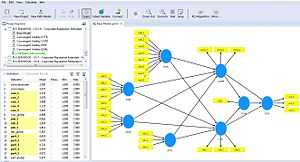Partial least squares path modeling
The partial least squares path modeling (PLS-PM, PLS-SEM) approach to structural equation modeling, is a component-based estimation procedure different from the covariance-based structural equation modeling approach. Unlike the covariance-based approach to structural equation modeling, PLS path modeling does not reproduce a sample covariance matrix. It is more oriented towards maximizing the amount of variance explained (prediction) rather than statistical accuracy of the estimates.
The PLS structural equation model is composed of two sub-models: the measurement model and structural model. The measurement model represents the relationships between the observed data and the latent variables. The structural model represents the relationships between the latent variables.
An iterative algorithm solves the structural equation model by estimating the latent variables by using the measurement and structural model in alternating steps, hence the procedure's name, partial. The measurement model estimates the latent variables as a weighted sum of its manifest variables. The structural model estimates the latent variables by means of simple or multiple linear regression between the latent variables estimated by the measurement model. This algorithm repeats itself until convergence is achieved.
PLS-SEM specific software
- Open source
- R has several contributed packages dealing with PLS path modeling such as the semPLS package.
-

SmartPLS 3 Screenshot; http://www.smartpls.com
References
- Hair, J.F.; Hult, G.T.M.; Ringle, C.M.; Sarstedt, M. (2014). A Primer on Partial Least Squares Structural Equation Modeling (PLS-SEM). Thousand Oaks, CA: Sage. ISBN 9781452217444.
- Vinzi, V. E.; Trinchera, L.; Amato, S (2010). Handbook of partial least squares. Springer Berlin Heidelberg.
- Afthanorhan, W. M. A. B. W. (2014). Hierarchical Component Using Reflective-Formative Measurement Model In Partial Least Square Structural Equation Modeling (Pls-Sem). International Journal of Mathematicsand Statistics Invention, 2 (2), 55-71.